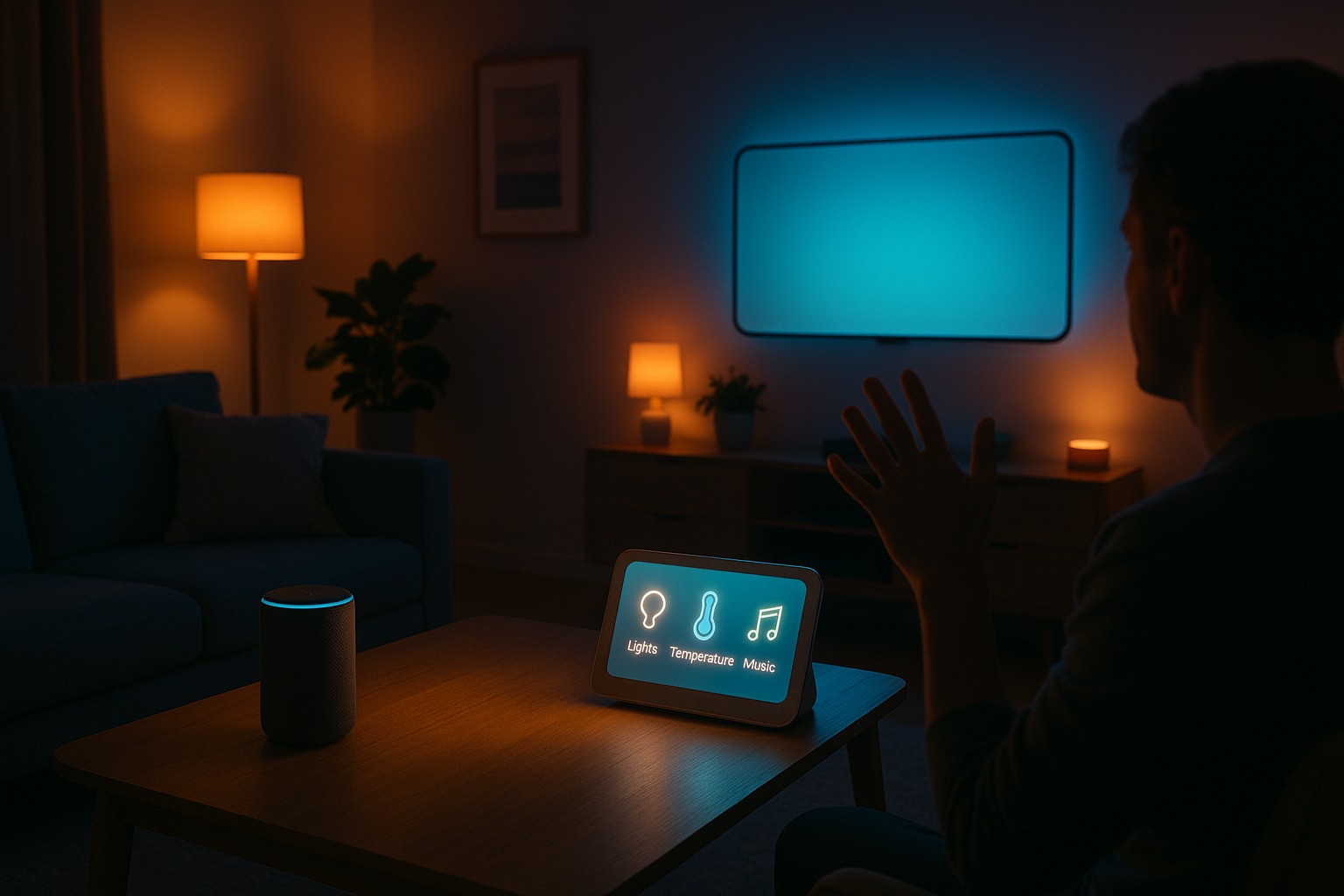Welcome to the future — where you no longer have to fumble for switches, remotes, or apps. With just a simple phrase like “Hey Google, turn on the lights” or “Alexa, play some chill music,” your entire smart home responds like magic. ✨
Voice commands have quickly become one of the most powerful and convenient ways to control a smart home. Whether you’re turning on your lights, adjusting your smart thermostat, checking who’s at the front door, or launching a Netflix show on your smart TV, voice control makes it all effortless — and hands-free.
In this guide, we’ll walk you through the top voice commands for smart homes, organized by categories like lighting, security, climate control, and more. Whether you use Amazon Alexa, Google Assistant, or Apple Siri, you’ll discover practical commands that make your daily routine smoother, faster, and even a bit more futuristic. 😎
From creating personalized smart home routines to troubleshooting unresponsive devices, we’ve got everything covered. Let’s unlock the full potential of voice-activated home automation together — one command at a time.
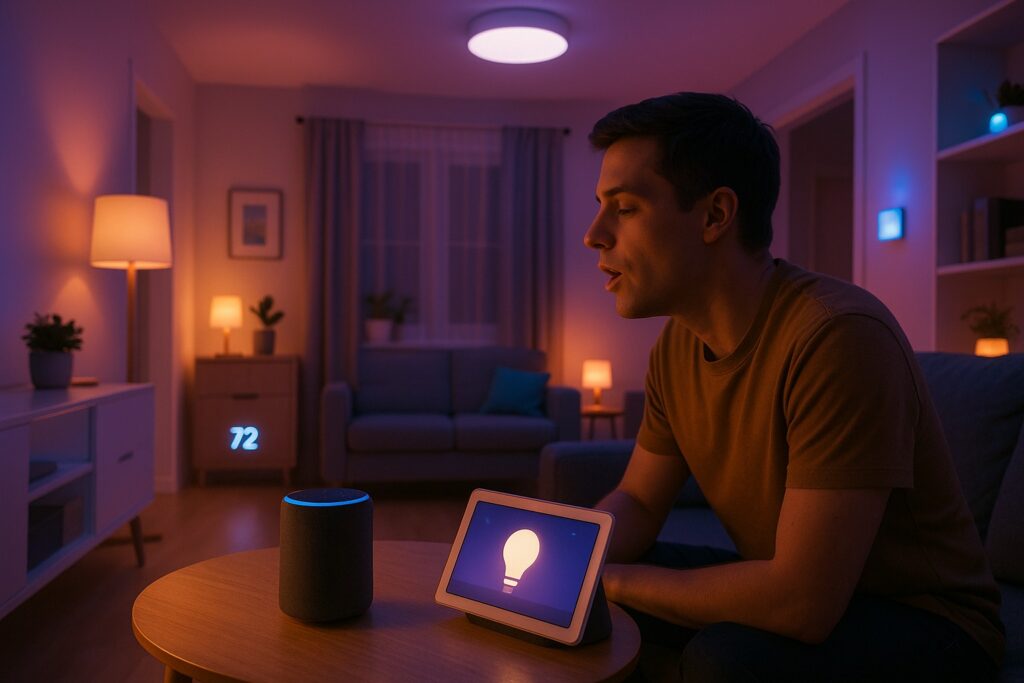
Top voice commands for smart homes include controlling lights (“Turn off the bedroom lights”), adjusting thermostats (“Set temperature to 72 degrees”), playing music or TV (“Play jazz on Spotify”), checking security (“Is the front door locked?”), and activating routines (“Good morning” or “Movie night”). These commands work with smart assistants like Alexa, Google Assistant, and Siri, offering hands-free control and enhanced home automation.
🧠 Why Voice Commands Matter in Smart Homes
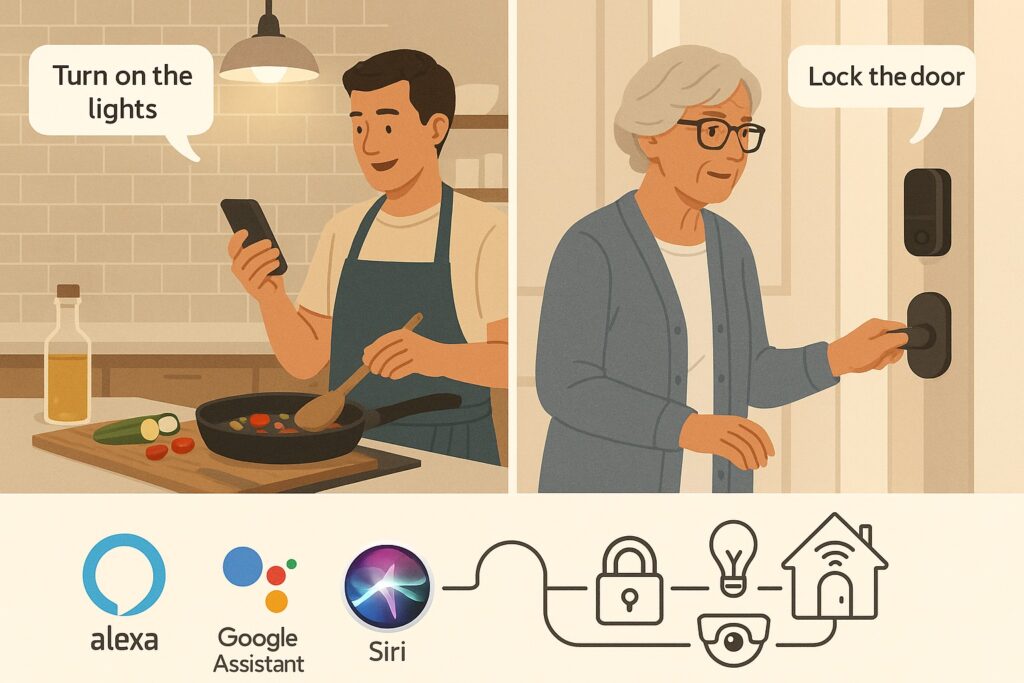
✅ Benefits of Hands-Free Smart Home Control
One of the biggest advantages of using voice commands in smart homes is the ability to control everything hands-free. Whether you’re cooking, carrying groceries, or just relaxing on the couch, a simple phrase like “Hey Alexa, turn on the fan” eliminates the need to reach for your phone or walk to a switch.
This hands-free convenience boosts the user experience, especially for the elderly, people with disabilities, or anyone seeking ease of access. It turns your smart home into a truly intelligent assistant that adapts to your lifestyle and responds instantly.
⏳ Time-Saving and Accessibility
Voice-controlled smart homes save you precious time by streamlining everyday tasks. Need to set a timer while baking? Want to dim the lights for movie night? With voice commands, you can do it all in seconds — no app navigation required.
Beyond speed, this tech also enhances home accessibility. Visually impaired users or those with limited mobility can operate smart devices effortlessly using their voice. That’s the beauty of inclusive smart home automation — it empowers everyone.
🔗 Integration with Smart Ecosystems (Alexa, Google Assistant, Siri)
Today’s voice assistants like Amazon Alexa, Google Assistant, and Apple Siri seamlessly integrate with a wide range of smart devices — from lights and thermostats to door locks and cameras. This tight integration allows users to build a cohesive smart ecosystem, where all devices can be controlled from one voice interface.
Whether you’re an Android fan with Google Nest devices, an Apple user hooked into HomeKit, or running your home with Alexa routines, you’ll enjoy smooth, cross-device compatibility and simplified control. It’s the foundation of any reliable and scalable smart home setup.
🎙️ Most Useful Voice Commands for Alexa, Google Assistant, and Siri
Voice assistants like Alexa, Google Assistant, and Siri are at the heart of smart home automation. With just a few simple phrases, you can control everything from lighting and temperature to entertainment and home security. In this section, we’ll explore the most practical, time-saving, and powerful voice commands — grouped by smart device type — to help you make the most of your setup.
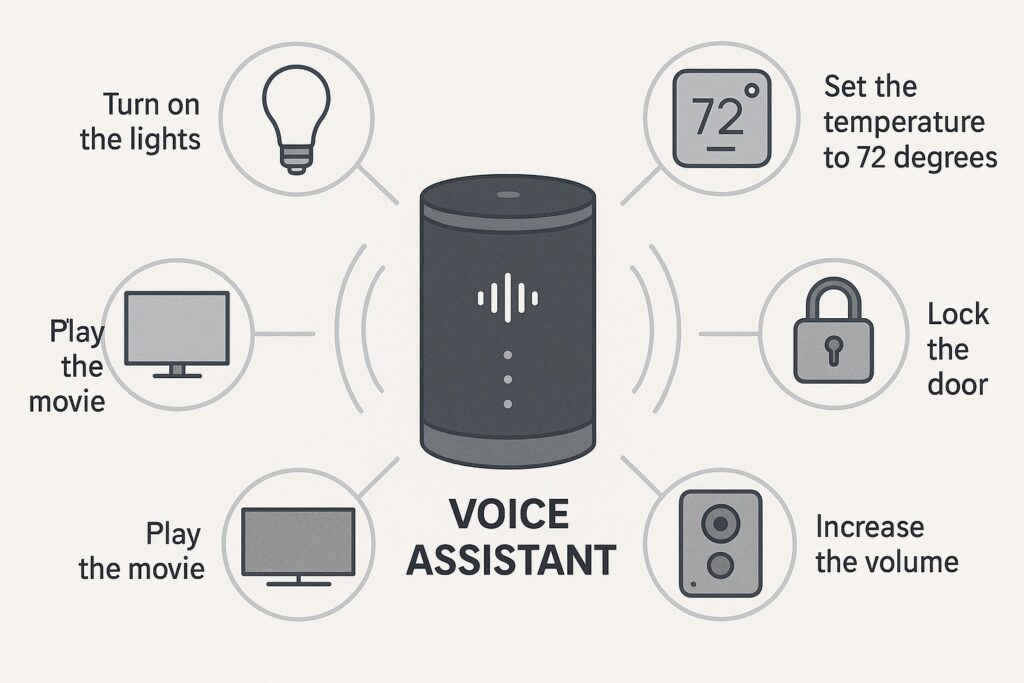
🔊 General Commands (All Assistants)
These basic commands work across most devices and provide a quick way to interact with your assistant. Whether you’re asking for information, setting reminders, or managing alarms, these are your everyday essentials:
- “What’s the weather today?”
- “Set a timer for 10 minutes.”
- “Remind me to take the trash out at 7 PM.”
- “What time is it?”
- “What’s the latest news?”
These voice commands are useful for day-to-day tasks and demonstrate how AI voice assistants streamline common actions in your smart home environment.
💡 Voice Commands for Smart Lights
Smart lighting is one of the first things most users automate, and voice control makes it effortless. You can adjust brightness, color, and power without lifting a finger:
- “Turn on the kitchen lights.”
- “Dim the living room lights to 30%.”
- “Set the bedroom lights to blue.”
- “Turn off all lights.”
Whether you use Philips Hue, LIFX, or TP-Link Kasa, these commands integrate perfectly with your smart lighting ecosystem and enable dynamic ambiance control.
🌡️ Voice Commands for Thermostats
Controlling your smart thermostat with voice is not only convenient — it can also help you save energy and maintain comfort throughout your home:
- “Set the temperature to 72 degrees.”
- “Turn on the heat.”
- “What’s the current temperature inside?”
- “Turn off the AC.”
Whether you’re using Nest, Ecobee, or Honeywell, these commands help you manage home climate with total ease, even while you’re busy or away.
📺 Voice Commands for Smart TVs and Entertainment
Your voice can also power your entertainment system. No more searching for remotes — just say the word, and your TV or speaker obeys:
- “Play Stranger Things on Netflix.”
- “Pause the TV.”
- “Increase the volume.”
- “Play jazz on Spotify.”
- “Turn off the TV.”
These commands work with platforms like Fire TV, Chromecast, Apple TV, and even smart soundbars, making your home entertainment experience smoother and smarter.
🔐 Security Commands
Keep your home secure with voice-activated security features. From checking the lock status to arming your system, voice assistants provide hands-free peace of mind:
- “Is the front door locked?”
- “Lock the back door.”
- “Arm the security system.”
- “Show me the front door camera.”
These commands integrate with smart locks (like August or Yale), video doorbells (like Ring or Nest Hello), and full security systems like ADT or SimpliSafe.
🔁 Routines and Scenes
Voice assistants let you bundle multiple actions into a single phrase using routines or scenes — making automation truly effortless:
- “Good morning” → Turns on lights, reads the weather, starts the coffee maker
- “Good night” → Turns off lights, locks doors, sets alarm
- “Movie time” → Dims lights, closes blinds, turns on the TV
- “I’m leaving” → Turns off all devices, arms security, adjusts thermostat
Routines can be fully customized, giving you complete control over how your smart home responds to your daily habits.
🧑🔧 Voice Command Setup Tips for Smart Home Beginners
Setting up voice commands in your smart home might feel intimidating at first, but it’s actually super simple when you follow a few basic steps. Whether you’re using Alexa, Google Assistant, or Siri, this section will walk you through how to connect your smart devices, create custom routines, and test commands for a smooth, responsive setup.
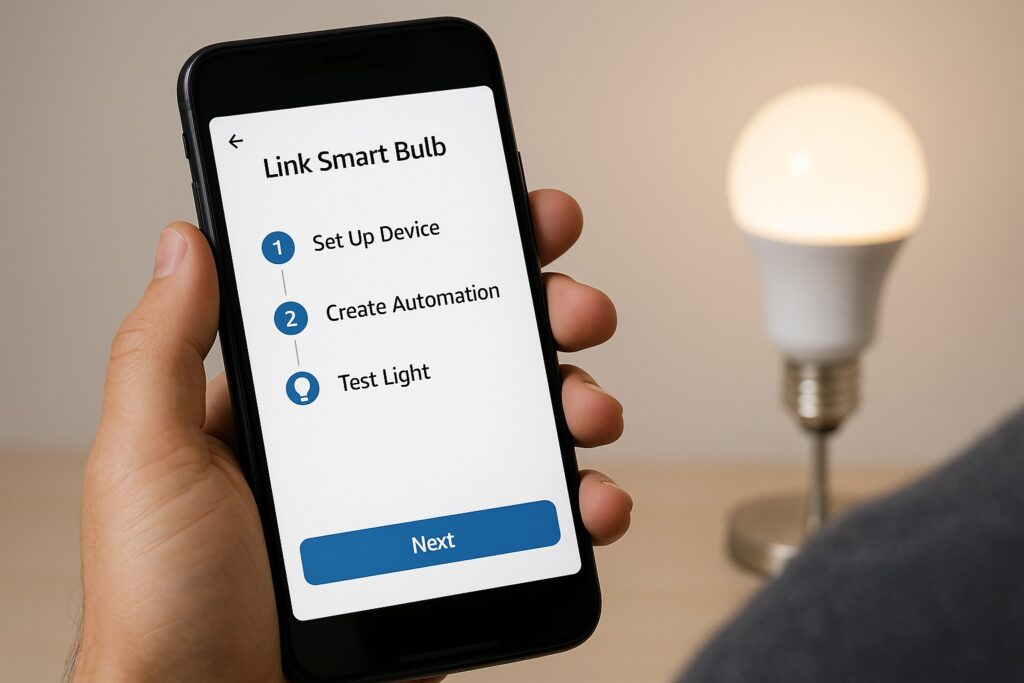
🔗 How to Link Devices to Your Voice Assistant
The first step to using voice control in your smart home is linking all your devices — such as smart lights, plugs, thermostats, cameras, and locks — to your chosen voice assistant. Most smart products come with their own mobile apps that guide you through the setup process.
Here’s the general process:
- Open the voice assistant app (Alexa, Google Home, or Apple Home).
- Tap “Add Device” or “Set Up Device.”
- Choose your brand (like Philips Hue, TP-Link, Ring, etc.).
- Log in to the manufacturer’s account to authorize connection.
- Assign the device to a room or group.
Once linked, you can start using smart home voice commands immediately. For example: “Alexa, turn on the hallway light” or “Hey Siri, open the garage.”
🛠️ Setting Up Custom Routines
Routines are where the real home automation magic happens. Instead of issuing individual commands for each device, you can bundle them into one voice-triggered routine. For example, saying “Good night” could turn off all the lights, lock the doors, and lower the thermostat — all at once.
To set up a routine:
- Open your voice assistant app.
- Navigate to “Routines” (Alexa), “Automations” (Google), or “Shortcuts” (Siri).
- Create a trigger (like a voice phrase or schedule).
- Add actions (like lights off, music on, temperature set).
- Save and test.
Custom routines boost both efficiency and personalization, making your smart home respond exactly the way you want.
✅ Testing Commands for Consistency
After setup, it’s essential to test your voice commands to make sure everything works reliably. Sometimes devices may not respond due to naming conflicts, weak Wi-Fi, or unlinked services.
Here are tips to test effectively:
- Use clear, natural language: “Turn on kitchen lights” vs “Activate illumination.”
- Make sure your devices are named logically (e.g., “Bedroom Light” not “Light1”).
- Run each routine to confirm all steps are triggered.
- Test from different rooms to check assistant responsiveness.
Frequent testing ensures smooth operation and helps identify bugs before they frustrate you. Plus, it helps train you (and your family) to use the correct commands with ease.
🧪 Advanced Smart Home Voice Control Tricks
Once you’ve mastered basic voice commands, it’s time to unlock the next level of smart home automation with advanced tricks that make your house feel truly intelligent. These voice control upgrades add context-aware automation and cross-platform integration, giving you more precision and flexibility.
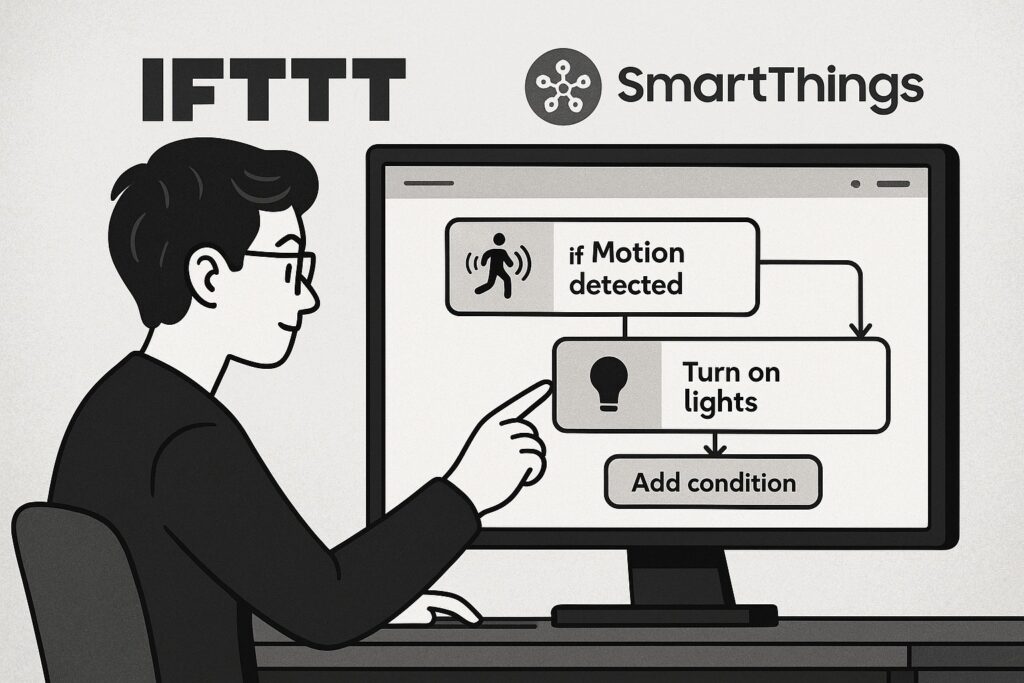
Let’s dive into two powerful methods: conditional voice commands and using IFTTT or SmartThings to expand your smart home’s capabilities.
🧠 Conditional Commands (“If motion detected, turn on lights”)
Conditional automation lets your smart home respond intelligently to events, not just voice prompts. For example:
“If motion is detected in the hallway after 10 PM, turn on the lights.”
This type of command usually requires setting up automations or routines through apps like Alexa Routines, Google Home Automations, or Apple Shortcuts — but once done, they work seamlessly with your voice assistant.
You can also use conditions like:
- Time of day
- Presence detection (e.g., “when I arrive home”)
- Sensor triggers (motion, contact, temperature)
These smart conditional voice setups transform your home into a context-aware ecosystem, reacting automatically based on what’s happening — not just what you say.
🔄 Using IFTTT or SmartThings with Voice Assistants
If you want to go beyond the default options in Alexa or Google Home, platforms like IFTTT (If This Then That) or Samsung SmartThings can supercharge your automation.
With IFTTT:
- You can link apps and devices that don’t normally talk to each other.
- For example: “If I say ‘Movie Time’ to Google Assistant, then dim LIFX lights and mute my Android phone.”
- You can even connect email, calendar, or social media to trigger smart home actions.
With SmartThings:
- You can create complex multi-device automations using one dashboard.
- It supports Zigbee, Z-Wave, and Matter-enabled devices for broad compatibility.
- Voice commands integrate naturally via Alexa or Google Assistant.
These platforms open the door to deep custom automations, helping you craft a voice-controlled home that’s uniquely yours.
🧩 Troubleshooting Voice Command Issues
Even in the smartest homes, things don’t always go as planned. Sometimes your voice assistant doesn’t respond, or a smart device ignores your command entirely. Don’t worry — these hiccups are common and usually easy to fix. In this section, we’ll break down the most common voice control issues and exactly how to troubleshoot them like a pro.
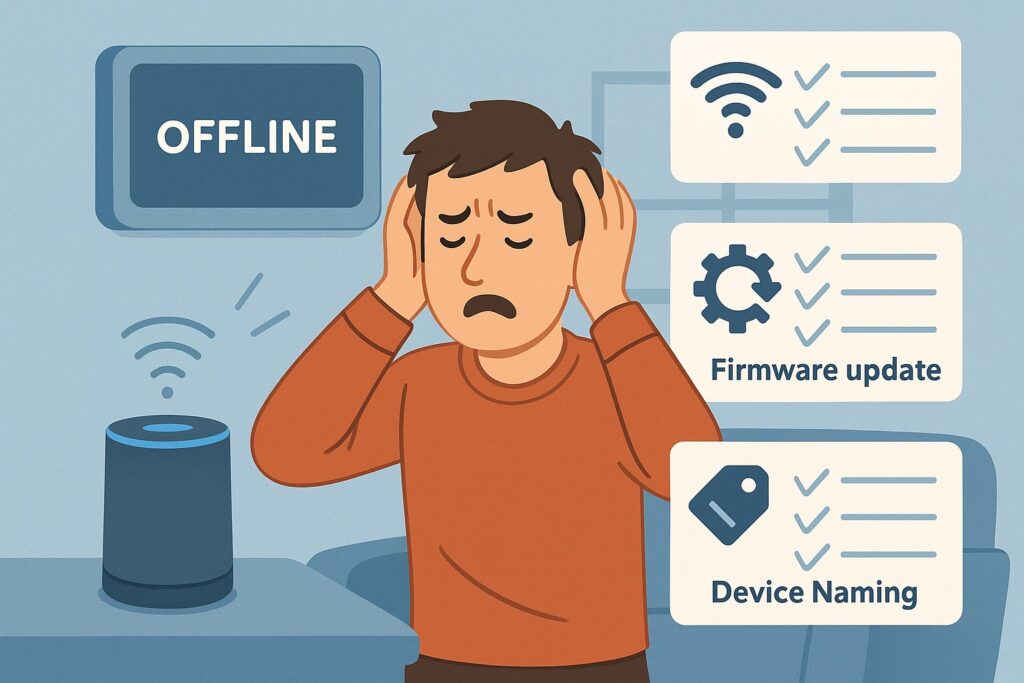
Let’s get your smart home back on track — and your assistant listening like it should! 🔧🎤
❌ Device Not Responding to Command
One of the most frustrating issues is when you say “Alexa, turn off the bedroom light,” and… nothing happens. 😤
Here’s what to check:
- Device power: Make sure the smart device is plugged in and powered on.
- Wi-Fi connection: A weak or lost Wi-Fi signal is a common cause of failure.
- Voice assistant connection: Open the app (Alexa, Google Home, or Siri/HomeKit) and ensure the device appears online.
- Name mismatch: If your command includes a room or device name that’s not recognized, it won’t respond. Double-check that the device name in the app matches your command.
⚠️ Common Errors and How to Fix Them
Let’s run through a few frequent issues and their solutions:
📛 1. Wrong Device Triggering
If saying “Turn on the lamp” activates the wrong one, you might have duplicate names or overlapping groups. Rename your devices clearly in the app (e.g., “Desk Lamp” instead of “Lamp”).
📶 2. Lag or Delay in Response
Delayed responses are often caused by network congestion or weak Wi-Fi. Try rebooting your router and placing smart hubs (like Echo or Nest Hub) closer to the device.
🧠 3. Assistant Misunderstands You
Voice assistants might hear “bedroom fan” as “bedroom lamp.” Speak clearly and use the exact phrasing configured in the app.
🔁 4. Linked Services Disconnected
Sometimes third-party apps (like Spotify, Philips Hue, or SmartThings) get unlinked. Go into your assistant app’s Skills or Linked Services section to reauthorize them.
🔄 5. Outdated Firmware
Smart devices need updates too! Make sure your devices and voice assistant apps are running the latest firmware.
📋 Downloadable Cheat Sheet of Top Voice Commands
Want a quick reference to keep by your desk, kitchen, or nightstand? We’ve got you covered! Below is a cheat sheet of the most useful smart home voice commands for Alexa, Google Assistant, and Siri — organized by category so you always know what to say to get things done.
| Category | Alexa Example | Google Assistant Example | Siri Example |
|---|---|---|---|
| General | “Alexa, what’s the weather?” | “Hey Google, what time is it?” | “Hey Siri, set a timer for 10 mins.” |
| Smart Lights | “Alexa, turn off living room lights.” | “Hey Google, dim the lights to 50%.” | “Hey Siri, set bedroom lights to blue.” |
| Thermostats | “Alexa, set temp to 72.” | “Hey Google, what’s the room temp?” | “Hey Siri, turn off the heat.” |
| Entertainment | “Alexa, play jazz on Spotify.” | “Hey Google, play Netflix on TV.” | “Hey Siri, play my workout playlist.” |
| Security | “Alexa, is the door locked?” | “Hey Google, arm the security.” | “Hey Siri, show me the front door cam.” |
| Routines/Scenes | “Alexa, good night.” | “Hey Google, movie time.” | “Hey Siri, I’m home.” |
| Smart Plugs | “Alexa, turn on the coffee maker.” | “Hey Google, switch off the fan.” | “Hey Siri, turn on the kettle.” |
📥 Download the Printable PDF Cheat Sheet
👉 Click here to download the Voice Command PDF Cheat Sheet
This printable version makes it easy to train your household, share with parents, or keep handy until these voice commands become second nature.
You will also like:

